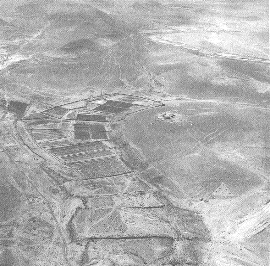Optimizing Agroforestry under Runoff Irrigation
This project was designed to investigate the effect of intercropping a fast-growing tree with local food crops on yields, biomass production, water and nutrient cycling in the drylands of North-Western Kenya using runoff irrigation. Several management interventions were tested such as planting density, tree and crop species and tree pruning. This research was stimulated by the discovery of ancient irrigation techniques in the Negev desert by Michael Evenari in the 50-ies and the subsequent investigations by Israeli researchers (Evenari, M 1989 The Awakening Desert. Springer, Berlin). Evenari found that the prehistoric inhabitants of the Negev had large townships in a desert area which could not support the calculated high population densities. The climate was not profoundly different during time of occupation from that of today. From aerial photos he concluded that the landscape was covered with walls and dams which may have been irrigation channels. Evenari reconstructed these irrigation systems and proved that farming is possible in a desert region with less than 150 mm annual rainfall. The first farm was Avdad, which is still in use today. Later it became clear that farmers had used runoff irrigation as early as 1000 BC, and this type of agriculture had its flourishing period during the age of the Nabataens (300 BC to 600 AD).

The principle of these irrigation techniques is quite simple, but the results are astounding. Rain water which does not infiltrate into the soil and therefore flows on the soil surface (so-called runoff) is collected by small stone or earthen dams and guided on agricultural fields. The water infiltrates into the soil and plants can grow using this water which is stored in the soil. The major advantage is that by having few but large irrigation events after floods the water infiltrates relatively deep into the soil profile and a lower proportion evaporates from the soil surface. Thus, one or two rainfall events which create runoff are sufficient to grow a crop.
Subsequent research with various fruit and fodder trees in the Negev has shown that during and after irrigation significant amounts of water in the topsoil between the tree rows were not utilized by the trees. This soil water may be more sufficiently used by an intercrop during these times of high water supply. During three years of research, we installed a runoff irrigation system in Northern Kenya, planted trees and grew 5 consecutive crops. We used Acacia saligna as the perennial fodder tree and cowpea and sorghum as annual intercrops. (more detailed description)
The runoff irrigation system allowed two cropping cycles per year in the dry tropical environment of Northern Kenya. Normally, local Turkana farmers do not risk cropping a second time during the short rains in August/September at all, because their seed supply is very limited and the short rains are unreliable and not productive enough. With two yearly crops, yields were reliable and could be improved with appropriate management techniques like mulching and tree pruning. The biomass production from our study was considerable compared to other studies in dry areas.
Because of the noticeable increase of biomass production in our system, the local Turkana population showed great interest in the activities of the research farm in Kakuma. As a result, recommendations could be given to farmers in the area interested in our techniques. The farm products of the research station proved to be highly sought after: not only the cowpea and sorghum grain yields, but also the fresh cowpea biomass for edible greens, leaf biomass for animal fodder, tree branches and sorghum stover as construction material for local houses of the Turkana and tree stems for fuel wood.
Another benefit of these systems is that the material costs for constructing the irrigation systems are low, as the structures only consist of compacted soil. Input requirements are small tools. Small runoff irrigation systems for use by individual farmers were shown to effectively collect runoff and required construction time of one week for a single family. The labor costs for construction and maintenance are considerable, however, and early financial returns are required to create sufficient incentives for the adoption of this technique.
A combination of trees and crops increased biomass production and therefore also increased the return for the investment of constructing the irrigation system. Experiments with fruit trees, such as mango, papaya, guava and citrus in the runoff irrigation system in Kakuma were very promising (more details). Fruit tree production would increase the monetary return and was shown to be economically feasible for high-value cash crops such as papaya.
